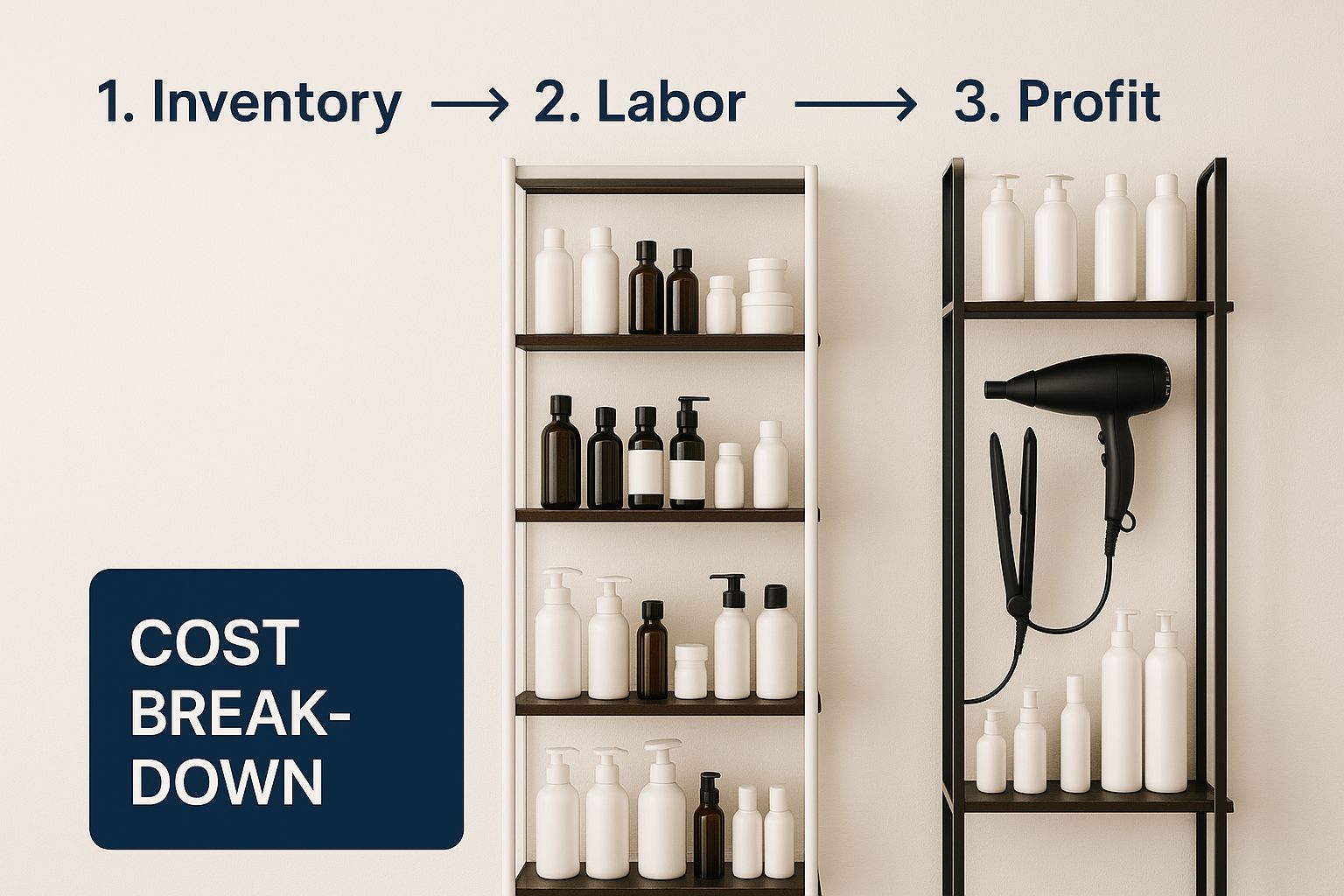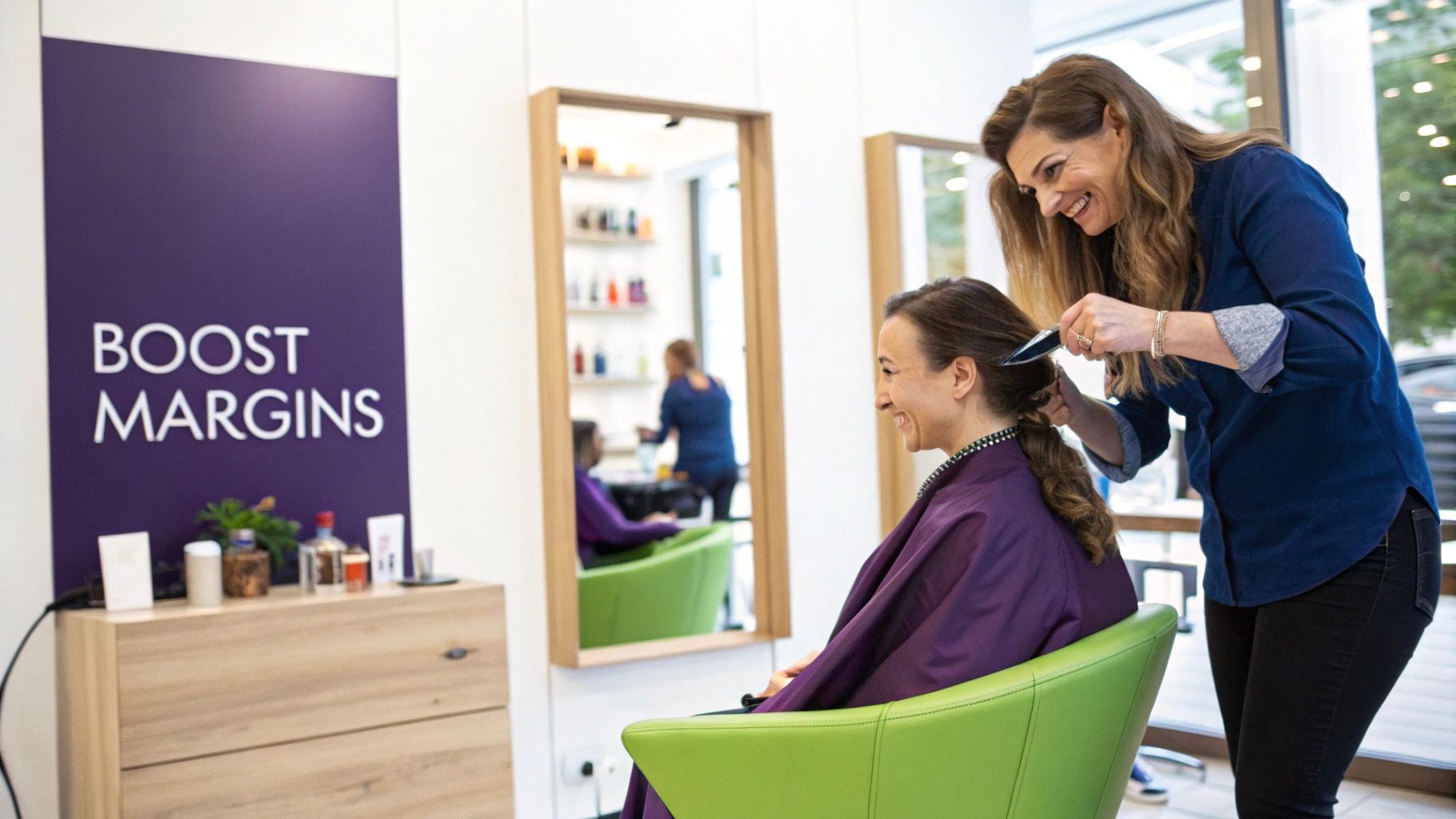Boosting Your Beauty Salon Profit Margins

When you hear that a healthy beauty salon profit margin is, on average, around 8.2%, it might not sound like much. But that number tells a powerful story. In reality, margins can swing wildly from a razor-thin 2% to an impressive 17%.
This percentage is the golden number—it's what's left in your pocket from every dollar you make after every single bill is paid. Understanding how to control this metric isn't just about accounting; it's about taking specific actions to build a thriving, long-lasting salon.
What Are Beauty Salon Profit Margins, Really?

Let's break it down with a simple, real-world example. Imagine you charge $100 for a haircut. That $100 isn't pure profit—not even close.
Before you can call any of that money your own, you have to subtract every cost that went into making that haircut happen. This includes the direct costs like shampoo and styling cream, but it also includes a portion of your monthly rent, the electricity for the clippers, and your stylist's commission.
After all those deductions are made, what’s left over is your actual profit from that one service.
Your profit margin is the ultimate report card for your business's health. It tells you exactly how efficient you are at turning revenue into real money in your bank account, not just how busy your appointment book is.
Grasping this concept is the first real step toward taking control of your salon's financial future. It shifts your mindset from just making sales to making profitable sales.
Why This Metric Matters So Much
Keeping a close eye on your beauty salon profit margins is a strategic necessity. It illuminates exactly where your money is going and helps you spot actionable opportunities for efficiency. A low margin, for example, is a clear signal to re-evaluate your pricing or audit your supply spending.
On the other hand, a healthy margin gives you the power to:
- Reinvest in Your Business: Purchase new equipment, fund advanced team training, or renovate your space.
- Build a Financial Cushion: Set aside money for slow months or unexpected expenses without stress.
- Grow and Scale Your Operations: Fund a second location or add a new, profitable service menu.
- Pay Yourself a Fair Salary: Ensure your hard work translates into a good personal income.
To give you a better sense of where you stand, it's helpful to look at key industry numbers. This table breaks down the essential metrics every salon owner should be tracking.
Key Financial Metrics for Your Salon
This table offers a snapshot of the essential industry benchmarks every salon owner should monitor to gauge financial health and identify growth opportunities.
| Metric | Industry Average | What This Means for You |
|---|---|---|
| Net Profit Margin | 8.2% | This is your bottom line. Aiming for 8% or higher means your business is financially healthy after all expenses are paid. |
| Gross Profit Margin | 80-85% | This measures the profitability of your services and retail before overhead. A high number shows your pricing is strong. |
| Staff Costs | 35-50% of Revenue | Your team is your biggest asset, but also your biggest expense. Keeping this in check is crucial for profitability. |
| Rent/Overhead | 10-15% of Revenue | This covers your physical space and utilities. A rate higher than 15% can seriously eat into your profits. |
| Cost of Goods Sold (COGS) | 5-10% of Revenue | This is what you spend on products for services and retail. Keeping COGS low directly boosts your gross margin. |
Looking at these benchmarks, you can see that the average 8.2% profit margin for salons is pretty standard across many small businesses. However, the range is huge, with some salons barely scraping by at 2% while top performers hit 17% or more. For more detail on these stats, joinblvd.com offers great insights on salon profitability.
What separates the high-flyers from the rest? It almost always comes down to smart pricing, tight control over expenses, and getting the most out of every stylist's time. The good news is that these are all things you can influence. The following sections will show you exactly how.
How to Calculate Your Salon's Profitability
Diving into your salon's numbers can feel intimidating, but the process is straightforward. Once you know how to calculate your profit margins, you'll be empowered to make smarter business decisions. Let's walk through the exact steps to measure your salon’s financial health, using simple formulas and a real-world example.
First, you need to understand two key types of profit margins: gross and net. Think of gross margin as a close-up on your service and retail profitability, while net margin is the wide-angle shot of your entire business's financial health.
Starting with Gross Profit Margin
Your Gross Profit Margin measures the profitability of your core offerings—services and retail products—before accounting for overhead like rent or salaries. It directly answers the question: "Are my services and products priced correctly?"
To find it, you first need your Cost of Goods Sold (COGS). This is the direct cost of products used to perform a service (like hair color) or the wholesale price of your retail items.
Here’s the simple, two-step process:
- Calculate Gross Profit:
Gross Profit = Total Revenue - Cost of Goods Sold (COGS) - Calculate Gross Profit Margin:
Gross Profit Margin = (Gross Profit / Total Revenue) x 100
A healthy gross margin, typically around 80-85% in the salon industry, indicates your pricing strategy is effective and your product costs are under control.
This image breaks down the essential costs you'll need to track for your calculations.

Visually separating your inventory costs (COGS) from your bigger overhead expenses is the first step to getting real clarity on your salon's financial performance.
Calculating Your Net Profit Margin
Next is the Net Profit Margin, the ultimate measure of your salon's profitability. It shows you the percentage of revenue left after all expenses are paid, including both COGS and operating costs.
Your net profit margin is your true bottom line. It's the money you actually keep to pay yourself, reinvest in the business, or save for a rainy day.
To calculate it, you just need to subtract your operating expenses. These are all the fixed and variable costs required to run your salon that aren't directly tied to a specific service.
- Operating Expenses Include:
- Rent or mortgage payments
- Staff salaries, commissions, and payroll taxes
- Utilities (water, electricity, internet)
- Marketing and advertising costs
- Salon software subscriptions
- Insurance and professional license fees
Here’s the formula to find your net profit margin:
Formula: Net Profit Margin = ( (Total Revenue - COGS - Operating Expenses) / Total Revenue ) x 100
A Practical Salon Example
Let's apply these formulas to a salon's monthly numbers:
- Total Revenue: $20,000
- Cost of Goods Sold (COGS): $3,000 (for color, backbar products, and retail inventory)
- Operating Expenses: $14,000 (for rent, salaries, utilities, and marketing)
First, let’s find the Net Profit:
$20,000 (Revenue) - $3,000 (COGS) - $14,000 (Operating Expenses) = $3,000 (Net Profit)
Now, calculate the Net Profit Margin:
( $3,000 / $20,000 ) x 100 = 15%
This salon has a net profit margin of 15%, which is exceptionally strong and well above the 8.2% industry average. This business isn't just busy; it's seriously profitable.
Making a habit of these calculations is a foundational step, and documenting them is even better. For a structured way to handle this, you might find our detailed spa business plan template helpful for organizing your financial projections and tracking your progress over time.
The Hidden Factors Draining Your Profits

Knowing how to calculate your beauty salon profit margins is step one. The next, more powerful step is to identify and fix what’s quietly eating away at those profits.
Profits are often lost through small, everyday inefficiencies. By focusing on four key areas—pricing, costs, service mix, and team productivity—you can find and plug these financial leaks for good.
Rethinking Your Service Pricing Strategy
Many salon owners set prices by looking at what nearby competitors charge. This is a mistake because it ignores what makes your salon unique: your brand, your stylists' expertise, and your specific costs.
Your pricing should be a strategy, not a guess. If you use premium products, have highly trained stylists, or offer a luxury experience, your prices should reflect that value. If you're constantly booked, it's a strong sign you may be undercharging.
Pricing isn't just about covering costs; it's about communicating your value. Charging too little can sometimes make clients think your services are lower quality, while strategic pricing cements your reputation as a premium provider.
Actionable Insight: Implement a tiered pricing structure. A "New Talent" stylist can have a more accessible price point to attract new clients, while a "Master Stylist" with years of experience commands a premium price. This caters to different budgets while showcasing your team's growth.
Taking Control of Your Salon Costs
Every dollar you save on expenses goes straight to your bottom line as pure profit. Effective cost control requires a deep dive into every outgoing payment.
Start by listing all your monthly expenses, from rent down to credit card processing fees. Those fees, typically 1.5% to 3.5% per transaction, can add up to thousands of dollars a year. Some POS systems allow you to pass a small portion of these fees to the client, which can be a significant saving.
Here are a few quick wins for controlling costs:
- Do a Product Audit: Check your inventory for expired or slow-moving products. Adjust your ordering to stop tying up cash in items that just sit on the shelf.
- Talk to Your Suppliers: Ask long-term suppliers for better rates or bulk-purchase discounts on your most-used items.
- Watch Your Utility Bills: Implement simple energy-saving habits. Switch to LED bulbs, ensure hot tools and lights are off when not in use, and service your HVAC system for efficiency.
Optimizing Your Service Mix for Profit
Not all services are equally profitable. A quick haircut might fill a slot, but a complex color correction often brings in more profit for the time spent. Analyzing your service mix is critical for maximizing revenue.
Actionable Insight: Dive into your sales data to identify your highest-margin services. These are your "rockstar" services. Once you know what they are, you can take immediate action:
- Spotlight High-Margin Services: Feature them prominently on your website, social media, and email newsletters.
- Train for the Upsell: Coach stylists to recommend these services during consultations when appropriate for the client.
- Create Smart Bundles: Offer a package deal—like a cut, color, and a high-margin keratin treatment—that highlights the premium service while offering great value to the client.
Boosting Staff Productivity and Efficiency
An empty chair is lost money. Minimizing downtime in your appointment book is one of the fastest ways to increase profit margins. This is where staff productivity and smart scheduling become your secret weapons.
Your salon software can automatically fill last-minute gaps and suggest profitable add-on services during online booking. Motivate your team with a commission structure that rewards them for upselling, hitting retail targets, and retaining clients. When your team is focused on maximizing the value of every appointment, everyone wins.
Global Trends and Your Local Market Opportunity
To truly optimize your beauty salon profit margins, you need to look beyond your own salon and understand broader industry trends. What’s happening in global markets is a preview of what your clients will want next, giving you a chance to get ahead of local competitors.
Major markets like the United States, set to reach $91.23 billion by 2025, and China are setting the pace for new services and client expectations. For example, the growing demand for personalized beauty treatments in the US is a huge opportunity.
Translating Global Insights into Local Action
Use global trends as a roadmap for your service menu. If personalized treatments are booming, consider adding bespoke facials or custom-blended hair color formulas.
These premium services carry higher profit margins because they shift the client's focus from price to value. They attract clients seeking expertise and a unique experience, not just a standard service.
Understanding whether your local market is more like the US with its hair care focus, or Europe with its growing demand for advanced skincare, helps you make smarter, more profitable decisions about where to invest your time and training.
This strategic thinking is vital from day one. For those just starting, our guide on how to start a beauty business explains how to integrate market research into your plan.
Spotting Your Niche Opportunity
The goal isn’t to copy every trend, but to adopt those that fit your brand and fill a gap in your local market. This helps you become a leader, not a follower.
Here’s a simple process to find your sweet spot:
- Analyze Your Service Mix: Are your most profitable services already aligned with a global trend? If so, double down on marketing them.
- Survey Your Clients: Directly ask them about services they've heard about or would like to try. Their answers are invaluable.
- Watch Social Media: Instagram and TikTok are hotbeds for new beauty trends. See what’s popular and brainstorm how you could offer your own unique version.
By staying informed about global trends, you can proactively protect and grow your beauty salon profit margins, ensuring your business remains relevant and profitable for years to come.
Actionable Strategies to Increase Salon Profits Now
You understand your numbers; now it's time for action. This is your playbook of concrete strategies to boost your beauty salon profit margins starting today. Each tactic is designed to either increase revenue per client or decrease operating costs—both of which directly improve profitability.
Launch a Simple and Effective Client Loyalty Program
Acquiring new clients is far more expensive than retaining existing ones. Yet, industry data shows only 45% of clients return for a second visit. A simple loyalty program is your best tool to combat this.
- What to Do: Implement an easy-to-understand program. A "points-per-dollar" system or a simple punch card is highly effective. For example, a client earns 10 points for every $100 spent, and 100 points can be redeemed for a free deep conditioning treatment or $10 off a service.
- Why It Works: It provides a tangible incentive for clients to rebook with you, dramatically increasing client lifetime value and turning one-time visitors into loyal regulars.
Create Service Bundles to Increase Your Average Ticket
One of the most effective ways to increase revenue is to encourage each client to spend a little more per visit. Service bundling achieves this without feeling like a hard sell.
You package several services together for an attractive price, making the client feel they've received great value while increasing your total sale.
Service bundling shifts the client's focus from cost to value. Instead of buying individual services, they're investing in a complete experience, which feels more luxurious and all-inclusive.
For example, create a "Total Refresh Package" that includes a cut, color, a deep conditioning gloss, and a professional blowout for one set price.
Transform Stylists into Client Educators to Boost Retail Sales
Your retail products are a potential goldmine with high profit margins. The key to unlocking this revenue is turning your stylists into educators.
- What to Do: Train your team to explain the why behind the products they use during a service. As a stylist applies a serum, they should explain what it does, why it’s right for that client's hair, and how to use it at home to replicate the look.
- Why It Works: This approach feels like expert advice, not a sales pitch. It builds trust and makes clients eager to purchase the recommended products. To learn more, check out our guide on social media marketing for beauty salons.
Comparing High-Impact Profit Strategies
This table helps you prioritize which strategies to implement first based on effort and potential impact.
| Strategy | Implementation Effort | Potential Profit Impact | Key to Success |
|---|---|---|---|
| Loyalty Program | Low | High | Simplicity and consistency are everything. Make it easy to understand and track. |
| Service Bundling | Low to Medium | Medium | Create bundles that offer genuine value and solve a client's "total look" problem. |
| Boost Retail Sales | Medium | High | Consistent team training and shifting the mindset from "selling" to "educating." |
| Optimize Scheduling | Low | High | Fully utilize your salon software's features for reminders and waitlists. |
Master one of these strategies, then move on to the next. The goal is progress, not perfection.
Leverage Salon Software to Slash No-Shows and Fill Gaps
Every no-show is lost revenue you can never recover. Modern salon software is your best defense against this profit drain.
Actionable Insight: Enable automated appointment reminders via text and email in your software to cut your no-show rate significantly. Use features that automatically notify a waitlist about last-minute cancellations, filling empty slots before they impact your bottom line. For more ideas, explore methods for streamlining business processes to maximize efficiency.
Building a Lasting and Profitable Salon Business
Building a salon that thrives for years requires a long-term strategy. Sustainable success is about more than just numbers; it's about creating a business with real, lasting value. A key, often overlooked, element is your salon's culture.
High staff turnover is a silent profit killer, draining resources through recruitment, training, and lost productivity. A positive culture where your team feels valued and supported is a direct investment in your bottom line. They stay longer, grow with you, and become your salon's biggest advocates.
The Power of Continuous Improvement
The most successful salon owners never stop learning. The beauty industry changes fast, and staying on top of new services, tech, and client desires is non-negotiable.
Turn financial reviews into a regular habit. By consistently monitoring your numbers, you can make small, smart adjustments before they become major problems.
A lasting business is built on a cycle of action, review, and refinement. This continuous improvement is what transforms a good salon into a great one, protecting your profits and your passion for years to come.
Take these key actions to build a resilient business:
- Invest in Education: Fund advanced training to keep your team's skills sharp and your service menu fresh. This keeps stylists engaged and justifies premium pricing.
- Listen to Your Clients: Actively solicit and use client feedback to improve your services and overall experience. Happy, loyal clients are the foundation of a stable business.
- Embrace Financial Fluency: Get comfortable with your numbers. This confidence empowers you to make bold, strategic moves that secure your salon's future.
For those starting out, this actionable guide on how to start a hair salon offers a great roadmap for building a profitable business from day one.
Ultimately, mastering your salon's profit margins gives you the creative freedom to do what you love, build a business you're proud of, and create a lasting legacy.
What's a Good Profit Margin for a New Salon?
In your first year, turning any profit is a major achievement. A realistic and healthy net profit margin target for a new salon is between 2% and 5%.
Your initial focus should be on building a loyal client base and controlling start-up costs. As your appointment book fills and your reputation grows, you can begin aiming for the industry average of 8.2% and beyond.
How Can I Increase Profits Without Raising My Prices?
Yes, you can absolutely increase profits without changing your price list. The key is to optimize your operations and increase the value of each client visit.
Start by conducting a thorough cost audit. Negotiate better rates with suppliers and train your team to minimize product waste. Next, focus on increasing your average ticket size through upselling and add-on services, like a deep conditioning mask or a relaxing hand massage. Finally, build a strong retail program. Educating clients on at-home care can add 10-25% to your revenue from high-margin product sales.
Here's a pro tip: Train your team to talk about at-home care during the service. When a product recommendation comes off as genuine, expert advice instead of a pushy sales pitch, it builds trust and makes clients eager to buy.
Are Booth Rental Salons More Profitable?
It depends entirely on your business model and goals. The booth rental model can offer a more predictable income and lower management overhead, potentially leading to higher net profit margins. However, your total revenue potential is limited by the number of booths you have.
A commission-based salon offers unlimited earning potential and full control over your brand and client experience. However, it comes with much higher operating costs and greater day-to-day management responsibilities.
Ready to build a stunning website that attracts clients and grows your business? gohappybeauty creates SEO-optimized websites designed specifically for beauty professionals like you. Get started with gohappybeauty today!
Grow your beauty business
Our focus is, and always will be, helping you improve your online presence and generate more business from your website. That is what we do, for you.

